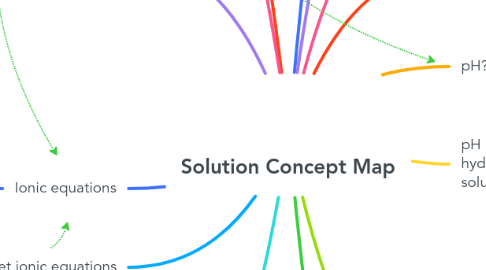
1. pOH
1.1. The pOH of an acidic solution is larger than 7, whereas that of a basic solution is less than 7.
1.1.1. Based on the hydroxide ion, the pOH scale determines how basic or acidic a solution is.
2. Spectator Ions
2.1. The ions that are present on both sides of chemical reactions but do not participate in them.
3. Preparation of standard solutions
3.1. 1. Weigh out substance.
3.2. 2. Dissolve solid in beaker with small amount of distilled water.
3.3. 3. Move the solution into a volumetric flask.
3.4. 4. Add distilled water until you reach the etch on the volumetric flask.
3.5. 5. Put stopper on the volumetric flask and start flipping it to make the make the solution homogeneous.
4. Ionic equations
4.1. An ionic equation shows spectator ions.
5. Net ionic equations
5.1. A net ionic equation does not show the speactator ions.
6. Acids and bases
6.1. defintion
6.1.1. base - Any molecule or ion that can take up a hydrogen ion from an acid is considered a base.
6.1.1.1. Properties of acids
6.1.1.1.1. taste = sour
6.1.1.1.2. pH = less than 7
6.1.1.1.3. Texture = rough
6.1.2. Acid - Any compound that contains hydrogen and has the ability to transfer a hydrogen ion, to another substance is considered an acid.
6.1.2.1. Properties of bases
6.1.2.1.1. Taste = bitter
6.1.2.1.2. pH = more than 7
6.1.2.1.3. Texture = slippery
6.2. Conjugate pairs
6.2.1. Example - H2O+NH3→NH4+OH−
6.2.1.1. 1st pair = H20 , OH-
6.2.1.1.1. H20 is the proton receiver and 0H- is the proton donator.
6.2.1.2. 2nd pair = NH3 , NH4
6.2.1.2.1. NH3 is the proton donator and NH4 is the proton acceptor.
7. What is a solution
7.1. A homogeneous mixture of two or more components is called a solution.
7.1.1. Types of solutions
7.1.1.1. gas solution
7.1.1.2. Solid solution
7.1.1.3. Liquid solution
8. Concentration
8.1. Molarity
8.1.1. M is the solute's moles per litre of solution. One liter of a 1.00 molar (abbreviated 1.00 M) solution contains one mole of solute per liter of solution.
8.1.2. Formula is moles of solute / litres of solution = molar concentration.
8.2. Molality
8.2.1. The formula for molality is m = moles of solute / kilograms of solvent.
